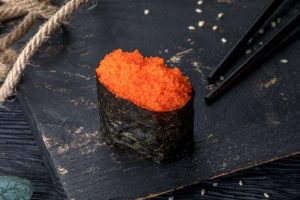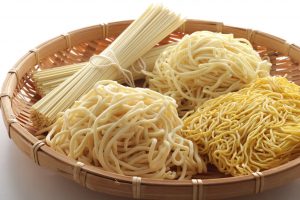
Customizable and totally Instagrammable, charcuterie boards (an artisanal do-it-yourself craft food) are taking the world by storm. And with their increasing popularity comes the demand for different types of cured meats such as capicola and mortadella. There are many types so it’s quite lengthy (and tricky) to discuss them all. To narrow it down, we’ll be focusing on what is salami, its different types, and how it tastes. And if you’re up for the challenge, you can also try to recreate some deli sandwiches at home. Or maybe even an antipasto platter too!
What Is Salami?
Before anything else, what is salami? Salami (or salame as the Italians call it) is a combination of cured meats that are either chopped or ground. Some special variations range from beef, lamb, and duck to venison, donkey, and even horse. Or sometimes a combination of these meats. However, the traditional sort uses pork mixed with salt and spices. To cure, it’s first encased in a hog casing.
Now, you may have heard of salumi before. While salumi is an umbrella term for Italian cured meats, salami, on the other hand, is a narrower term that includes dry cured meats that are either fresh or cooked.
Whichever type of meat you use, all salami has a salty, porky taste, and a fatty mouthfeel often enjoyed on a charcuterie board or deli sandwiches such as this muffaletta sandwich.
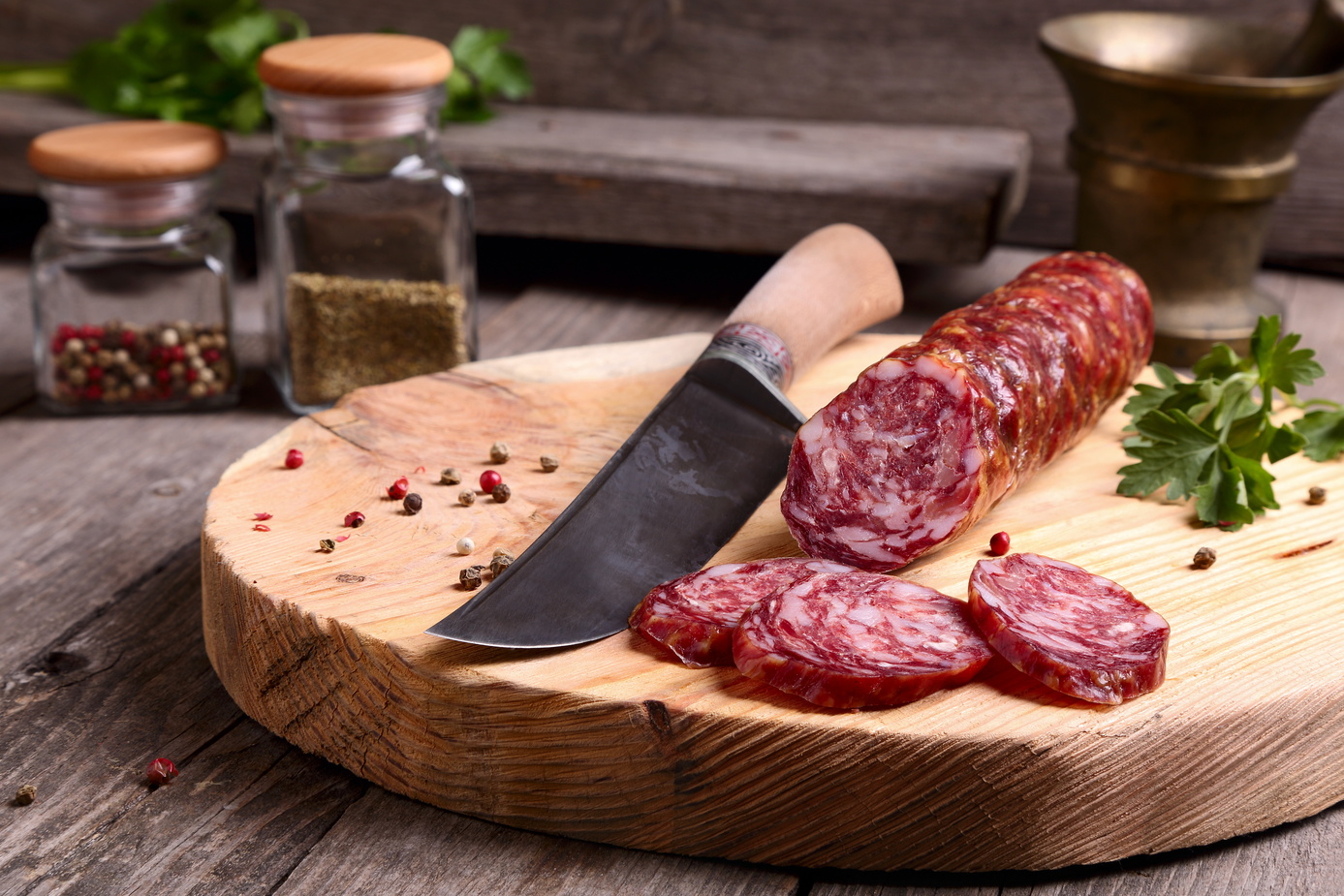
This brings us to one important topic: Is salami healthy? Or is salami bad for you? Though it comes with certain health benefits such as vitamin B12, vitamin B6, vitamin B3, thiamin, and more, it’s not exactly the healthiest food choice. In fact, the noticeable salty taste proves just that as it’s high in sodium. To be exact, there are about 1,890 milligrams of sodium per 100 grams of salami. It also has 441 grams of calories and 41 grams of fat per 100 grams of serving.
All in all, it’s not the ideal healthy food you’re looking for. Still, it can fit into a healthy diet but in moderation or occasional indulgence along with your favorite Italian cheeses.
Did You Know?
There are hidden allergens in salami. Some types of salami may contain nuts and nutmeg.
How Is Salami Made
Knowing what it is, what types of meat it contains, and its health benefits make you wonder how is salami made.
The process starts by grinding the meat with the help of a meat grinder. Again, that’s either beef, lamb, duck, venison, donkey, horse, a combination of these meats, or the traditional sort which is pork. But whichever type of meat, it’s important to select parts that have the perfect fat-to-lean meat ratio. For pork, shoulder and fatback are often the choices. After grinding the meat, you can add flavor enhancers such as salt, black pepper, paprika, garlic, herbs, and nuts. And then encase them in hog casings or cleaned pig’s intestines. The last step would be to hang them up and cure them.
This whole process is known as dry-curing. The process is very time-consuming. In the case of salami, curing takes about 6 to 10 weeks to mature. It may take longer depending on your preferences and curing conditions. Still, you can eat them as soon as they are firm to the touch. But the firmer and harder the salami is, the better.
Types of Salami
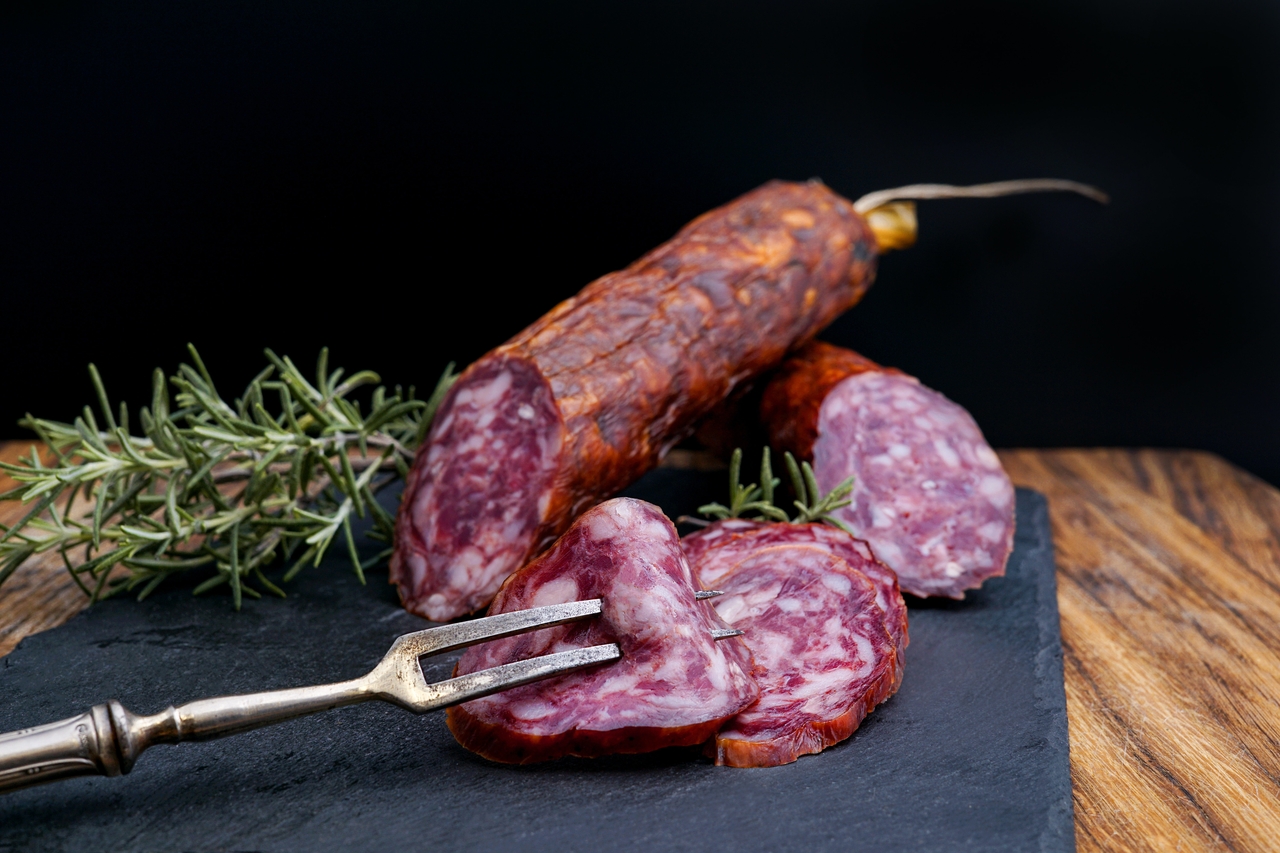
When one hears of salami, the Italian sausage would be the instant thought. Well, that’s only half correct. Italian “cured” sausage is the more exact term. And there are many types depending on the meat, which part of the pig, and the spices used.
In Italy alone, there are about 150 different types so we might not be able to list them all here. Still, below are some of the popular types that you may have heard or tasted on charcuterie boards.
Genoa Salami
As the name suggests, this type of salami originated in Genoa, Italy. It commonly uses pork. But sometimes may also consist of veal and beef. The meat is flavored with red wine, pepper, and garlic. Overall, you can say it has a funky, sort of cheesy smell but a soft, greasy, and fatty taste. Appearance-wise, you’ll notice that it is bright red, sausage-like, and dotted with bits of fat.
Prosciutto
Undeniably, prosciutto is one of the popular salumi types prized for its sweet and delicate flavor. It’s also the cured meat you often see in antipasto, charcuterie boards, and deli sandwiches. It’s made of pork leg (sometimes shoulders) seasoned by hand (often with salt).
In the charcuterie boards, you’ll often recognize it through its pink to deep pink color. You’ll also often see it sliced very thinly like a waffle.
Capicola
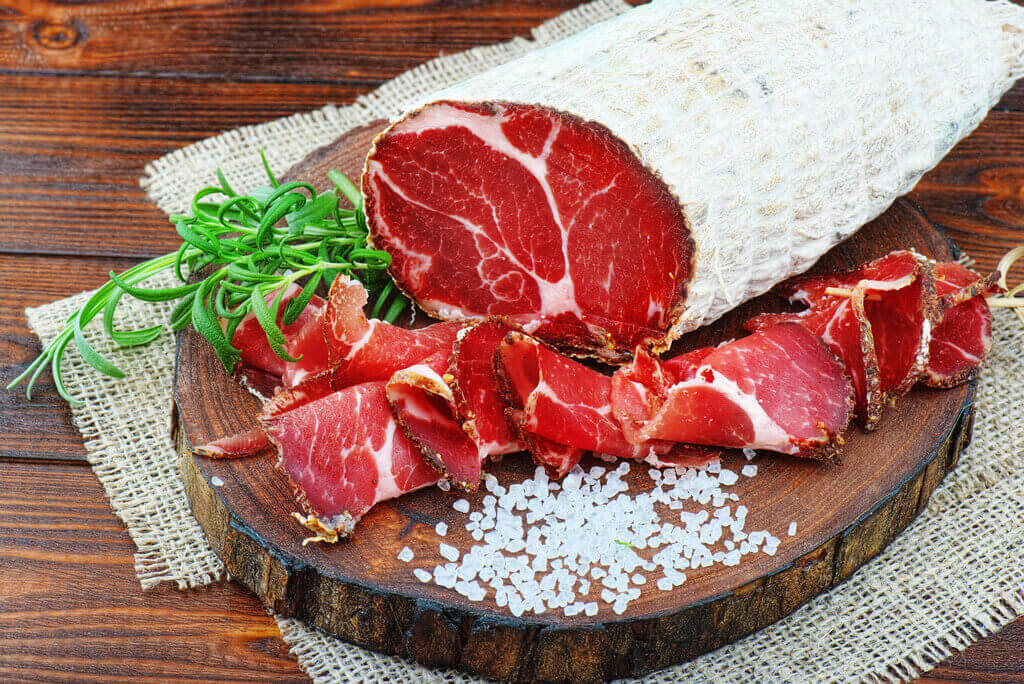
Capicola (also known as capocollo, cappo and capicollo in Italy) is a type of cured meat made from pork neck and shoulder. You’ll often see it sliced very thinly like prosciutto. It has a rich, fatty, and smoky flavor often paired with other types of cheese like Provolone and Gruyere in charcuterie boards. Additionally, it’s also one of the famous choices of cold cuts for sandwiches.
Pancetta
Made from pork belly, pancetta is another type of salt-cured meat. The meat is seasoned with pepper and other spices. Overall, it has some of the bacon’s qualities including the distinct porky and savory flavor. However, pancetta doesn’t have bacon’s unique smoky taste. It’s often the choice of meat for authentic Italian carbonara.
Did You Know?
Pancetta is known as Italian bacon because it’s made from pork belly just like bacon.
Soppressata
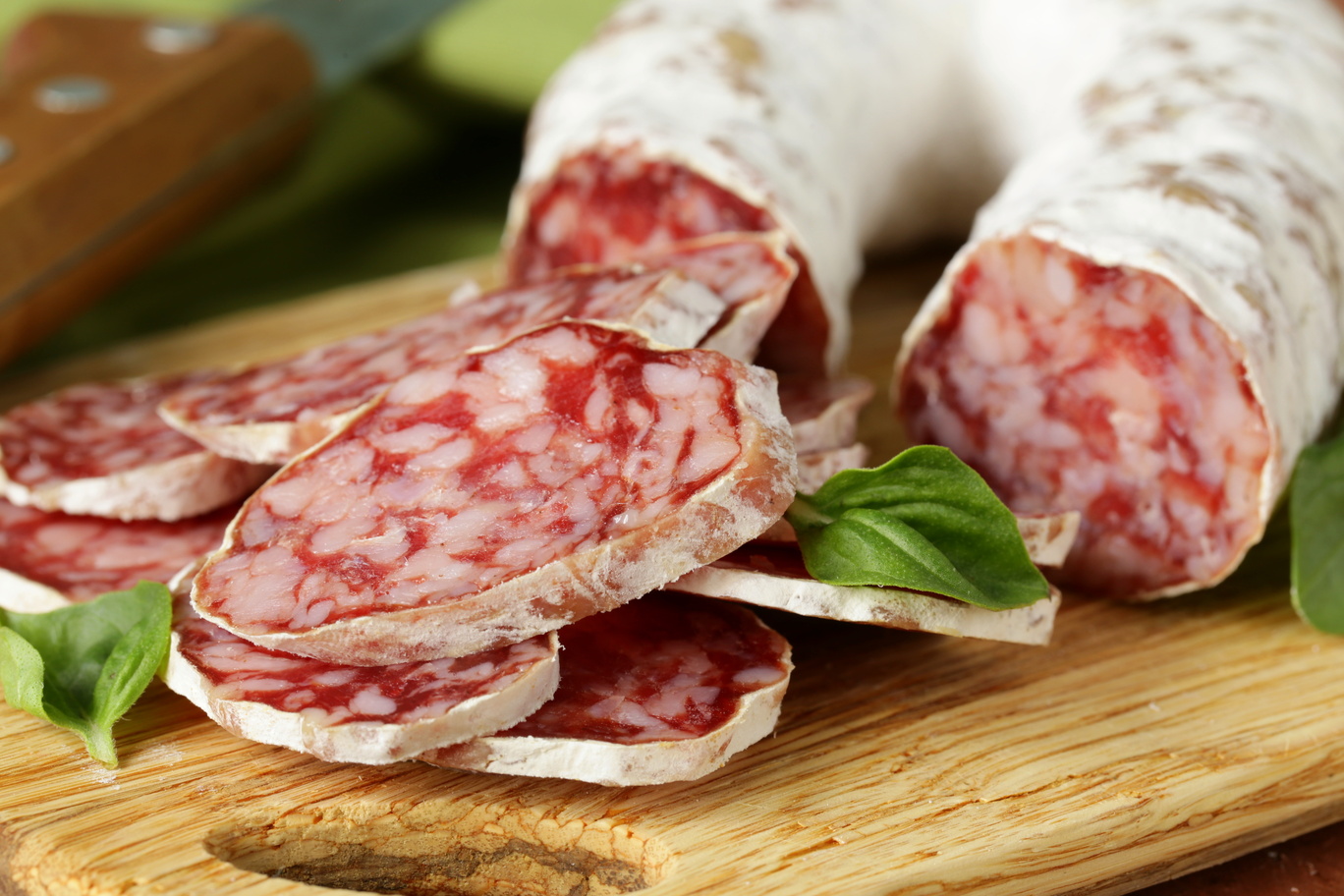
Soppressata (meaning pressed down) is an Italian dry salami that uses less desirable parts of the pig such as the stomach, tongue, and ham scraps that’s been pressed down. Hence, the name. But it can also contain pork belly and loin seasoned with spices and herbs that varies depending on the region. The basics, however, are garlic, peppers, fennel, oregano, and basil. With different spices and seasoning, flavors range from sweet to savory.
Felino Salami
Felino salami (also known as the king of salami) is named after the town it originated: Felino. It is made with lean pork shoulder, belly, and fatback flavored and seasoned with salt, cane sugar, garlic, and Chianti red wine. These flavor enhancers give Felino salami its intriguing rich taste, smooth texture, and bright red color.
Finocchiona Salami
Made of ground pork mixed with fennel seeds and black pepper, finocchiona salami is a dry-cured salami from Tuscany, Florence in Italy. Once you taste it, you’ll notice an intriguing sweet, anise flavor thanks to fennel. In Italy, finocchio means fennel which is one of the main components of this salami.
Milanese Salami
Milanese salami, better known as Milano salami from where it’s made (Milan, Italy), is cured meat made from a combination of pork butt, beef chuck, and pork fatback. It’s well-known for its bright red color with meat sweeter than the Genoa salami. It also has a distinct nutty flavor that blends in nicely with the best cheeses like Provolone and mozzarella.
Napoletano Salami
Napoletano (also known as Neapolitan salami) is a variety of dry, cured meat produced in Napoli, Italy. It’s usually made of pork but some recipes also use veal mixed with fatback seasoned with pepper, chili flakes, garlic, and wine.
READ ALSO: 70 Authentic Italian Recipes That’ll Take You to Italy
Other Types of Salami

Hard Salami
First things first, hard salami is different from Genoa salami. Though they look identical, they are not the same. It’s also said to be made in Central Europe, either in Germany, Poland, or the Czech Republic instead of Italy. Hard salami is made of made with pork or beef. Or sometimes, a combination of both seasoned with garlic and pepper. It also has a lighter appearance and a chewier mouthfeel than Italy’s salami.
READ ALSO: Genoa Salami vs Hard Salami: What’s the Difference?
Pepperoni
While not an Italian salami, we believe pepperoni deserves a spot on this list. After all, it’s one of the popular types. Pepperoni is an American salami made from beef and pork. Seasoned with chili peppers and paprika, pepperoni can easily be recognized through its spicy and smoky flavor. This salami has a special place in Italian-American cuisine as it’s used as a pizza topping and as an additional morsel for meat and cheese platters.
Spanish Chorizo
Many consider Spanish chorizo as more of a sausage than a salami. But since it goes through a similar curing process as salami (rather than being left uncured or raw like other sausages), it can be considered as one. Chorizo is a cured meat made of pork or beef packed with herbs and spices. It has a smoky flavor and aroma that’s quite different from other types of salami. It’s also seasoned with garlic and pimentón (Spanish smoked paprika) which gives it its deep red color as well as smoky flavor.
Unlike salami though, chorizo is considered to be one of the best Spanish breakfasts alongside scrambled eggs or Spanish tortillas rather than as an addition to charcuterie boards.
Cured vs Uncured Salami
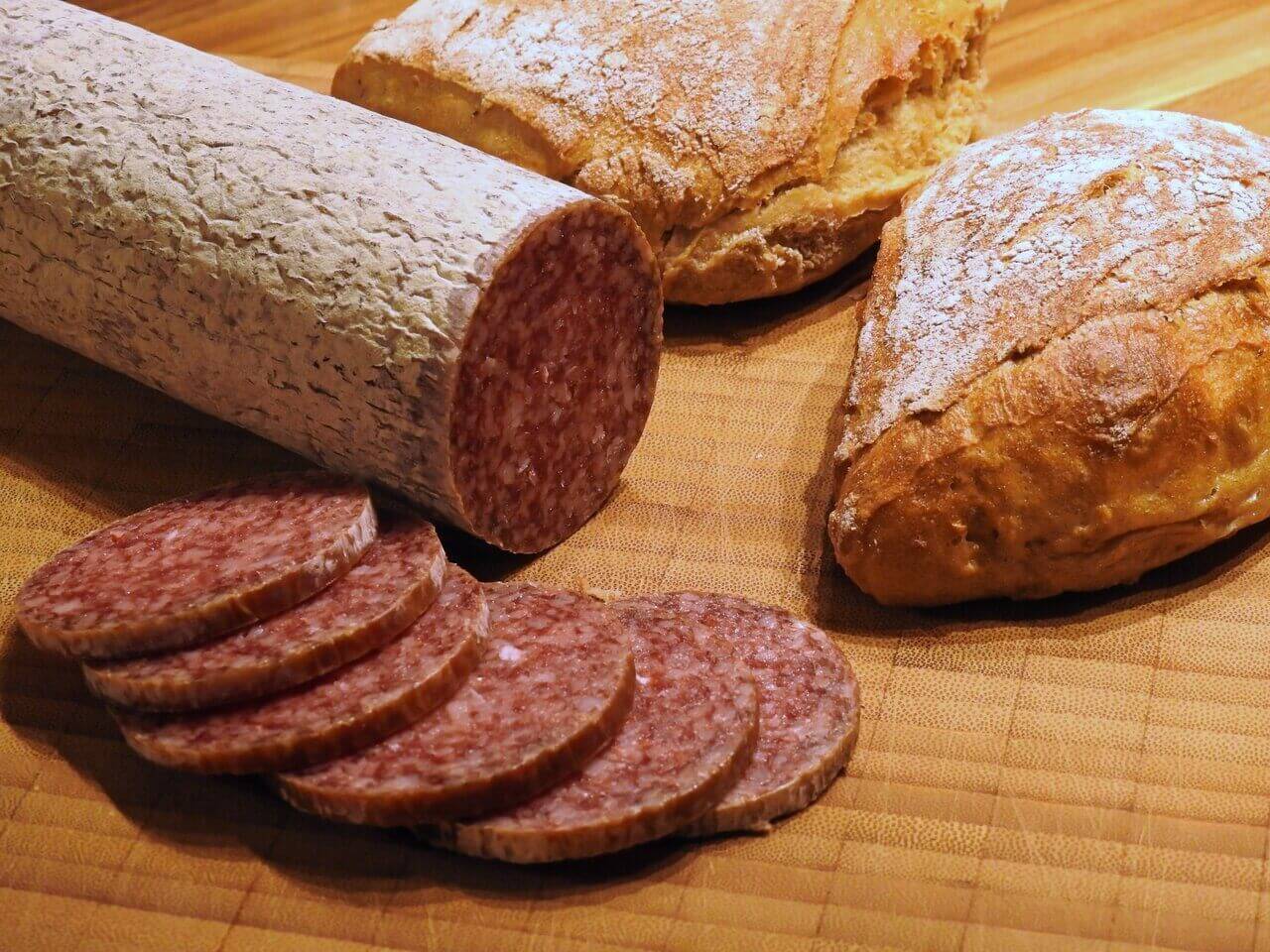
There are two groups of salami in the United States: cured and uncured. There’s not much difference except their curing agents. Cured salami simply means the curing agents used are salt and chemical additives. Meanwhile, uncured salami simply uses natural agents such as salt.
As you noticed, most on the list above use salt. But pepperoni, in particular, uses ascorbic acid in addition to salt. Some also use Instacure. But don’t be confused, uncured meat is still cured.
Where to Buy Salami
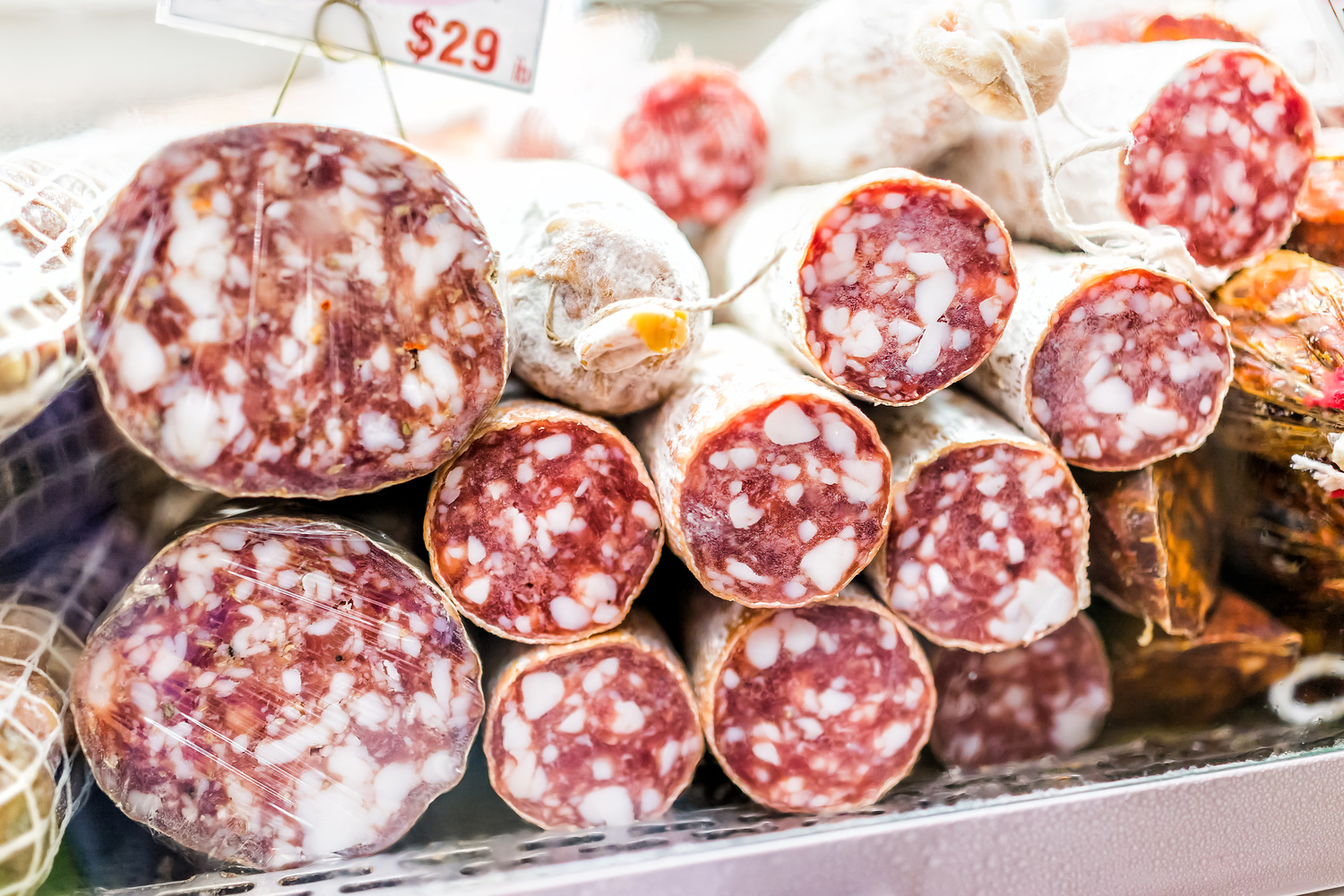
You can spot cold cuts in the deli aisle along with ham, sausages, and rotisserie chicken. If not, you can buy it from specialty retailers. Once you spot it, you’ll find that there are two sorts on the counter: pre-sliced and whole salami. We recommend getting the pre-sliced sort as it’s usually cut thinly which is harder to achieve at home.
If you’re looking for dry-cured salami and your local grocery store doesn’t have it, you can purchase it online.
How to Store Salami
Since salami is a live product, it will continue to cure or dehydrate even after you open the package. To dehydrate it more, placing it in the best condition is important. Water creates an environment for bacteria to thrive. So, make sure to avoid placing it in spaces where water is more likely to touch it like the kitchen counter or near the sink.
When storing on the kitchen counter, place it in a secured space where it’s elevated from the counter. The best storage space, however, is your pantry. Just loosely wrap it in brown either in a paper bag, baking paper, or dry tea towel and store it in a basket or kitchen organizer.
There are some types that can be stored in the refrigerator or freezer, though! To know the best way to store it, check the label first.
Delicious Salami Recipes to Try

Indeed, salami is a famous cured meat used in charcuterie board recipes. But reserving it only for meat and cheese platters is such a waste. Add it to your favorite sandwiches and pasta instead. Or better yet, check out the recipes below.
- Copycat Subway Cold Cut Combo – This cold-cut sandwich combines several cold cuts such as turkey, ham, mortadella, and salami for a savory and intriguing sandwich you won’t get enough of.
- Watercress Salad with Salami – Salami can also be added to salads. If you want, you can even replace bacon in your favorite salad recipe. Or better yet, you can start with this watercress salad which combines tart goat cheese and savory salami.
- Ciabatta Sandwich With Prosciutto – If you’re looking for something simple, then try this ciabatta sandwich. Here, prosciutto has a chance to really stand out as it only has tomatoes, arugula, and mayonnaise. It’s simple and delicious.
- Antipasto Platter – If you still want to try cheeseboards, try this recipe! It features different types of cold meats like salami and coppa paired with cheeses. Salami especially complements Provolone and Asiago.
Frequently Asked Questions
Is salami halal?
It depends on the type of salami and what meat is used. Some types substitute pork with beef and veal like Napoletano and Genoa salami. Some specialty recipes also use lamb, venison, horse, and turkey which are all halal.
Is it okay to eat salami raw?
Yes, you can safely eat salami raw. This is possible because the meat has been dehydrated preventing bacteria from inhabiting it.
Why does salami have a weird aftertaste?
If ever you chance a salami with a weird sour aftertaste, don’t worry. The sour taste is simply because of the fermentation process which produces lactic acid. Now, if it has a metallic, blood-like taste, continue to cure it. It’s a sign that the meat isn’t cured thoroughly.
What is the white stuff inside salami?
The white part inside the salami is not mold. The big chunks of white are simply fat pieces from the pork fatback and are completely safe to eat.
Was this page helpful?
Read Next: Best Mortar and Pestle Recipes to Make

